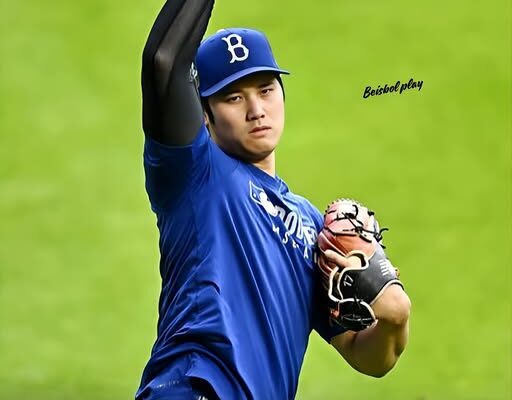Shohei Ohtani, the most electrifying player in modern baseball, has never been one to rest on his accomplishments. Even while dominating the league as a hitter and captivating fans with his larger-than-life presence, Ohtani remains driven by an unrelenting desire to compete as a complete player. Recently, he voiced a sentiment that sent a ripple through the baseball world: he’s already eager to return to the mound. “I already want to pitch,” he stated bluntly, revealing his growing impatience with the wait and his burning urge to get back to doing what he was born to do.
The statement came during a media session in the midst of a season where Ohtani has continued to dazzle with his bat, delivering home runs at an eye-popping rate and showing no signs of slowing down offensively. Yet even as he racks up runs and RBIs, Ohtani’s true identity—his core—is that of a two-way player. Not being able to pitch eats away at him in a way that underscores just how rare and remarkable his mindset is. For most players, the kind of dominance he’s shown at the plate would be more than enough. For Ohtani, it’s only half the picture.
Since undergoing elbow surgery in 2023, Ohtani has been strictly a designated hitter, an elite one at that. The Los Angeles Dodgers, with whom he signed a record-shattering deal, have approached his recovery with careful precision. They’re taking no shortcuts, aiming to preserve his longevity while protecting their massive investment. But no matter how cautious the organization may be, Ohtani’s own internal clock ticks with increasing volume. He wants to return to the mound—not eventually, but now.
It’s not a reckless desire; it’s a competitive one. Ohtani is acutely aware of what it means to pitch at the Major League level. He knows the toll it takes, the risk of reinjury, the grueling rehab process he’s endured twice already. But what drives him isn’t naïveté—it’s conviction. He thrives on the challenge. The mound, to him, is not merely a platform—it’s a proving ground.
His impatience isn’t rooted in ego. It’s rooted in identity. Since his early days in Japan, Ohtani’s vision for himself has always been two-fold: pitcher and hitter. It’s how he prepared. It’s how he trained. It’s how he views the game. Being limited to only one aspect of baseball, even while excelling at it, has felt incomplete to him. That sense of incompletion is what’s fueling his growing desire to return sooner rather than later.
Teammates and coaches have noted Ohtani’s restlessness—not in the form of frustration or negativity, but in his intensity during bullpen sessions, his curiosity in pitcher meetings, and his sideline observations. Despite not throwing in games, he’s been mentally immersed in the pitching side of the game all season. He studies hitters as if he were about to face them. He critiques delivery mechanics. He watches video as if preparing for his next start. All of this indicates that Ohtani’s return to pitching isn’t a matter of if, but when.
The Dodgers’ training staff has remained tight-lipped on the exact timeline, but they’ve consistently said that 2025 is the target year for Ohtani’s return to pitching. That’s always been the plan. Yet Ohtani’s body, according to his own admission, is responding exceptionally well. His recovery has been smooth. He’s ahead of schedule in some phases. And most importantly, he feels like a pitcher again.
That feeling is difficult to quantify, but for a competitor like Ohtani, it matters. Feeling the ball come off his fingers just right during light throwing. Sensing balance in his lower half during bullpen dry runs. Building rhythm with his motion, even in low-intensity sessions. These are the subtle cues that tell a pitcher that they’re ready. And for Ohtani, they’re whispering more and more loudly.
Despite his eagerness, Ohtani isn’t likely to push past the boundaries of his recovery plan. He’s too intelligent and disciplined for that. But his desire alone has meaning. It’s an insight into the kind of athlete he is—one who isn’t content simply being the best designated hitter in the game. He wants to reclaim the part of his game that once made him a unicorn in a sport steeped in specialization.
The significance of Ohtani’s eventual return to pitching cannot be overstated. When healthy, he’s a top-of-the-rotation talent. His fastball sits in the high 90s, his splitter is devastating, and his breaking pitches are sharp and unpredictable. During his peak seasons as a two-way player, he wasn’t merely serviceable as a pitcher—he was elite. He struck out batters at a rate comparable to the best arms in the league while limiting damage with remarkable poise and command. There’s a reason he won MVP while doing both jobs simultaneously—it was because he did both jobs at an All-Star level.
As a pitcher, Ohtani brings something few others do: intimidation combined with finesse. Batters don’t just have to worry about his velocity; they have to contend with his unpredictability, his pitch sequencing, his ability to command both sides of the plate. And unlike most pitchers, he knows how hitters think—because he is one. That dual perspective gives him an edge few can match.
From a team perspective, the Dodgers know what’s at stake. They invested in Ohtani not just for what he brings at the plate, but for what he can offer on the mound. They understand that his value multiplies exponentially when he’s a two-way force. His return to pitching doesn’t just add another starter to the rotation—it transforms the team’s strategy and ceiling.
Fans, too, are waiting. While they’ve been treated to Ohtani’s explosive offense and graceful base-running all season, the anticipation of seeing him toe the rubber again adds another layer of excitement. Ohtani pitching again will feel like a restoration—a return to the version of baseball he made possible. He didn’t just reintroduce the two-way concept to the modern game; he legitimized it, setting a standard that has forced coaches, scouts, and executives to rethink player development.
Until that moment arrives, we’ll continue to see glimpses. A few long tosses here. A video of a bullpen session going viral. Updates from insiders about velocity progress or mechanics refinement. And in the background, Ohtani will keep preparing, keep working, keep visualizing his return.
What separates Shohei Ohtani from nearly every other elite athlete isn’t just his skill, but his mindset. He’s not driven by external accolades or media adoration. He’s driven by a deep internal compass that demands excellence in every facet of the game. That’s why even after an MVP award, record-setting contracts, and global stardom, he’s still not satisfied. He wants to pitch again because, in his heart, that’s where the game feels most alive.
So when he says, “I already want to pitch,” it isn’t a casual comment. It’s a signal. A warning to the rest of the league that the most dangerous player in baseball is about to get even more dangerous. When that day comes, whether it’s spring 2025 or sooner, baseball will once again witness something rare: a complete player, at the height of his powers, doing what no one else can.
And when Ohtani finally walks out to the mound again, glove in hand, eyes locked in, crowd roaring—he won’t just be returning to pitch. He’ll be reclaiming the full scope of his identity. The wait may continue for a while longer, but one thing is clear: Shohei Ohtani isn’t losing patience because he’s tired. He’s losing patience because he’s ready.



